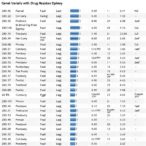
A large-scale observational study recently published in the journal Heart presents compelling evidence that walking at a brisk pace significantly lowers the risk of developing various heart rhythm abnormalities, including atrial fibrillation, tachycardia, and bradycardia. This extensive analysis, leveraging data from over 400,000 participants in the UK Biobank, sheds critical light on the relationship between physical activity, specifically walking speed, and cardiac arrhythmias—conditions that often lead to serious cardiovascular complications, sudden cardiac death, and long-term disability.
While numerous epidemiological studies have long associated physical activity with improved cardiovascular outcomes, this research uniquely focuses on the impact of self-reported and accelerometer-measured walking pace on incident cardiac arrhythmias. The authors emphasize the rising prevalence of arrhythmias worldwide, noting that atrial fibrillation alone has nearly doubled in cases over the past thirty years, reaching an estimated 60 million affected individuals in 2019. The study’s findings underscore the potential of modifiable lifestyle factors, such as walking speed, to mitigate these increasing risks.
Participants were categorized based on their walking pace: slow (3 miles per hour), average/steady (3–4 miles per hour), and brisk (>4 miles per hour). This stratification aligns with existing physical activity guidelines and enables nuanced analysis of how incremental differences in physical exertion may influence cardiac health. Notably, those walking at average or brisk speeds demonstrated substantial risk reductions for arrhythmias, with brisk walking linked to a 43% lower risk of all heart rhythm abnormalities after adjusting for a broad array of demographic and clinical confounders.
The scope of the study is reinforced by its longitudinal design, with participants tracked for approximately 13 years. During this period, 9% developed some form of heart rhythm abnormality. Crucially, the data revealed that faster walking paces were consistently associated with healthier lifestyle profiles: smaller waist circumferences, lower body weight, stronger grip strength, and decreased levels of metabolic risk factors such as fasting glucose and blood lipids. These metabolic indicators are themselves known contributors to cardiac arrhythmogenesis, suggesting a biologically plausible pathway linking increased walking speed to reduced arrhythmia incidence.
Further reinforcing these findings, the subset of participants who provided accelerometer-based data demonstrated that more time spent walking at brisk speeds was accompanied by a 27% reduced risk of developing arrhythmias. This objective measurement method mitigates potential biases of self-report and offers compelling support for physical activity as a modifiable factor in cardiovascular risk management. Intriguingly, time spent walking at a slow pace did not confer such benefits, underscoring the importance of intensity alongside duration.
The study also explored the intermediary mechanisms that might account for the association between walking pace and arrhythmia risk. Metabolic and inflammatory factors were found to mediate roughly 36% of the relationship, highlighting the role of systemic inflammation and metabolic health as critical pathways. Walking faster not only reduces obesity and improves glucose metabolism but also attenuates inflammatory activity, cumulatively lowering the substrate for arrhythmia development.
Importantly, the protective associations were most pronounced in specific populations—namely women, individuals under 60 years old, those without obesity, people with hypertension, and those having two or more chronic conditions. These subgroups may derive particular benefit from brisk walking interventions, indicating potential avenues for tailored public health strategies aimed at reducing arrhythmia burden.
While the findings hold substantial promise, the authors acknowledge inherent limitations intrinsic to observational research. Causality cannot be definitively established, and factors such as self-reported walking speed and a predominantly White, middle-aged cohort constrain the generalizability of results. Nonetheless, the biological plausibility and consistency with prior epidemiological data lend credence to the hypothesis that increasing walking pace can favorably influence heart rhythm stability.
This groundbreaking study pioneers the integration of both self-reported and accelerometer-based metrics in cardiac arrhythmia research, elucidating complex interrelations among physical activity, metabolic health, inflammation, and arrhythmogenesis. The objective quantification of walking intensity via wearable technology represents a significant advance in risk stratification and preventive cardiology.
In light of these insights, brisk walking emerges not only as a feasible and accessible form of exercise but also as a potent, non-pharmacological strategy to mitigate the growing global burden of cardiac arrhythmias. Translating these findings into public health messaging and clinical recommendations may have profound implications for cardiovascular morbidity and mortality reduction.
Given the rising numbers of individuals affected by atrial fibrillation and related arrhythmias—conditions responsible for substantial healthcare costs and loss of quality-adjusted life years—this research adds vital evidence endorsing lifestyle modifications to counteract these trends. Future investigations encompassing diverse populations and randomized intervention trials will be crucial to confirm these associations and refine exercise prescriptions.
Ultimately, this study substantiates that not all walking is equal in the context of cardiac health; faster walking paces yield marked cardiovascular benefits by modulating underlying metabolic and inflammatory pathways. Public health initiatives encouraging brisk walking could thus play a strategic role in preventing arrhythmias and improving population health outcomes worldwide.
Subject of Research: People
Article Title: Association of self-reported and accelerometer-based walking pace with incident cardiac arrhythmias: a prospective cohort study using UK Biobank
News Publication Date: 15-Apr-2025
Web References:
https://doi.org/10.1136/heartjnl-2024-325004
References:
Heart Journal, DOI: 10.1136/heartjnl-2024-325004
Keywords: Risk factors, Cardiac arrhythmias, Atrial fibrillation, Walking pace, Physical activity, Metabolic health, Inflammation
Tags: atrial fibrillation risk factorsbrisk walking health benefitscardiac arrhythmias epidemiologycardiovascular health researchexercise impact on cardiovascular conditionsheart health and physical activityheart rhythm abnormalities preventionlifestyle factors and heart diseasephysical activity guidelinestachycardia and bradycardia linksUK Biobank study analysiswalking speed and heart health


